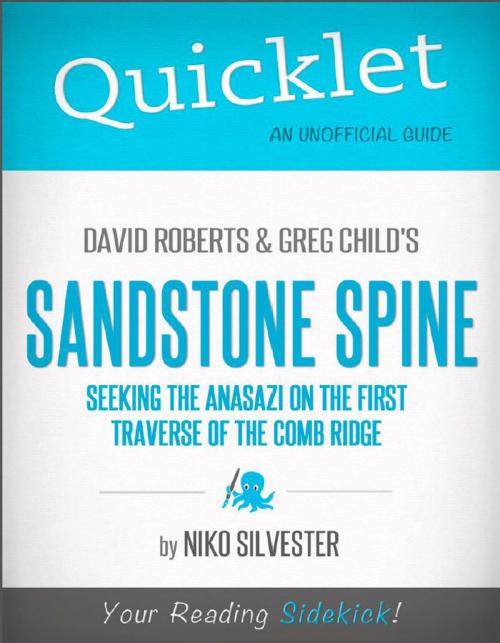Quicklet on David Roberts and Greg Child's Sandstone Spine: Seeking the Anasazi on the First Traverse of the Comb Ridge (CliffNotes-like Book Summary and Analysis)
Nonfiction, Reference & Language, Study Aids, Book Notes, Art & Architecture, General Art| Author: | Nicole Silvester | ISBN: | 9781614646440 |
| Publisher: | Hyperink | Publication: | July 30, 2012 |
| Imprint: | Hyperink | Language: | English |
| Author: | Nicole Silvester |
| ISBN: | 9781614646440 |
| Publisher: | Hyperink |
| Publication: | July 30, 2012 |
| Imprint: | Hyperink |
| Language: | English |
ABOUT THE BOOK
In this book, I have chosen sometimes to be deliberately vague about the name and location of certain prehistoric ruins and rock art. Such an ethic is by now in long use among writers, photographers, and guides who celebrate the Southwest. A narrative of personal discovery should not serve as a treasure map.”
Roberts’ and Child’s book Sandstone Spine is an account of the expedition of three men along Comb Ridge, a sandstone ridge resembling a miniature mountain range and running for nearly an hundred miles across Arizona and Utah. This area is full of archaeological ruins, primarily from various phases of the Anasazi people, as well as more recent Navajo sites. While the basic premise of the book is a recounting of Roberts’, Child’s, and their friend Vaughn Hadenfeldt’s experiences during the arduous expedition along the length of the Ridge, the structure and additional content of Sandstone Spine make it much more than simply an account of an hiking trip. Interspersed between sections recounting the events of the hike are retellings of historical events significant to the area, and information on both the current Navajo inhabitants and the prehistoric Anasazi people. Roberts also includes geological and natural history information, arranging all of this content into a fascinating mosaic of a book.
The book narrates how, while searching for a new expedition, author David Roberts and long-time hiking and climbing partner Vaughn Hadenfeldt wondered whether or not anyone had ever hiked Comb Ridge from end-to-end in one trip. As it seemed that no one had ever made a complete traverse of the Ridge, the two friends decided to try it themselves, and they both agreed that photographer and mutual friend Greg Child would be the perfect third party to join them on the expedition.
At ages 47, 53 and 61 respectively at the time of their trip, Child, Hadenfeldt, and Roberts had spent their lives making adventurous forays into some of the most inaccessible places on Earth. Both Roberts and Child made good livings writing about their adventures, while Hadenfeldt ran a business guiding hiking trips into the Utah canyonlands. The level of expedition and adventure-writing experience that Roberts and Child have ensures that their book includes interesting and relevant information for readers. Roberts did considerable research after the trip to complement the daily journals he kept.
Sandstone Spine was published by The Mountaineers Books, which also published some of Roberts’ other titles. The publisher is a part of The Mountaineers Club, a non-profit dedicated to “the exploration, preservation, and enjoyment of outdoor and wilderness areas.” In keeping with its publisher’s philosophy, Sandstone Spine is very much a book about enjoying the outdoors in a respectful and non-destructive way.
EXCERPT FROM THE BOOK
Over the years, Greg, Vaughn, and I had found literally hundreds of Anasazi ruins in the backcountry. Yet the thrill of coming upon a new one—especially one so beautiful as this—was undiminished.
Chapter One describes the preparations that Roberts, Child, and Hadenfeldt make for their expedition. As the area they wish to traverse has unreliable water supplies, the men decide on a water-caching system, in which they visit key locations along the ridge by driving and day-hiking, and leave plastic bottles of water where they can easily find them again. They also decide to arrange for another friend to meet them at certain dates at points where highways and road access penetrate the ridge, so they won’t have to pack a whole month’s worth of food. This will also allow them to swap out equipment if necessary. Hiking the whole length of Comb Ridge also requires permits...
...buy the book to continue reading!
ABOUT THE BOOK
In this book, I have chosen sometimes to be deliberately vague about the name and location of certain prehistoric ruins and rock art. Such an ethic is by now in long use among writers, photographers, and guides who celebrate the Southwest. A narrative of personal discovery should not serve as a treasure map.”
Roberts’ and Child’s book Sandstone Spine is an account of the expedition of three men along Comb Ridge, a sandstone ridge resembling a miniature mountain range and running for nearly an hundred miles across Arizona and Utah. This area is full of archaeological ruins, primarily from various phases of the Anasazi people, as well as more recent Navajo sites. While the basic premise of the book is a recounting of Roberts’, Child’s, and their friend Vaughn Hadenfeldt’s experiences during the arduous expedition along the length of the Ridge, the structure and additional content of Sandstone Spine make it much more than simply an account of an hiking trip. Interspersed between sections recounting the events of the hike are retellings of historical events significant to the area, and information on both the current Navajo inhabitants and the prehistoric Anasazi people. Roberts also includes geological and natural history information, arranging all of this content into a fascinating mosaic of a book.
The book narrates how, while searching for a new expedition, author David Roberts and long-time hiking and climbing partner Vaughn Hadenfeldt wondered whether or not anyone had ever hiked Comb Ridge from end-to-end in one trip. As it seemed that no one had ever made a complete traverse of the Ridge, the two friends decided to try it themselves, and they both agreed that photographer and mutual friend Greg Child would be the perfect third party to join them on the expedition.
At ages 47, 53 and 61 respectively at the time of their trip, Child, Hadenfeldt, and Roberts had spent their lives making adventurous forays into some of the most inaccessible places on Earth. Both Roberts and Child made good livings writing about their adventures, while Hadenfeldt ran a business guiding hiking trips into the Utah canyonlands. The level of expedition and adventure-writing experience that Roberts and Child have ensures that their book includes interesting and relevant information for readers. Roberts did considerable research after the trip to complement the daily journals he kept.
Sandstone Spine was published by The Mountaineers Books, which also published some of Roberts’ other titles. The publisher is a part of The Mountaineers Club, a non-profit dedicated to “the exploration, preservation, and enjoyment of outdoor and wilderness areas.” In keeping with its publisher’s philosophy, Sandstone Spine is very much a book about enjoying the outdoors in a respectful and non-destructive way.
EXCERPT FROM THE BOOK
Over the years, Greg, Vaughn, and I had found literally hundreds of Anasazi ruins in the backcountry. Yet the thrill of coming upon a new one—especially one so beautiful as this—was undiminished.
Chapter One describes the preparations that Roberts, Child, and Hadenfeldt make for their expedition. As the area they wish to traverse has unreliable water supplies, the men decide on a water-caching system, in which they visit key locations along the ridge by driving and day-hiking, and leave plastic bottles of water where they can easily find them again. They also decide to arrange for another friend to meet them at certain dates at points where highways and road access penetrate the ridge, so they won’t have to pack a whole month’s worth of food. This will also allow them to swap out equipment if necessary. Hiking the whole length of Comb Ridge also requires permits...
...buy the book to continue reading!















